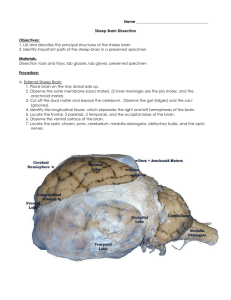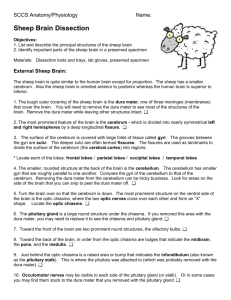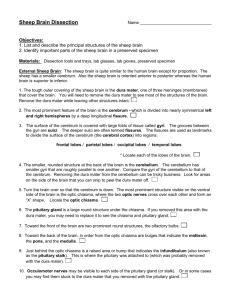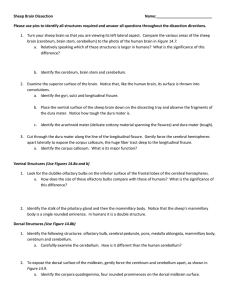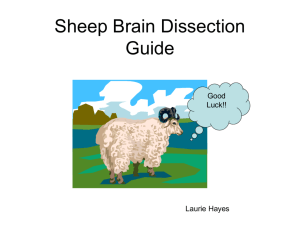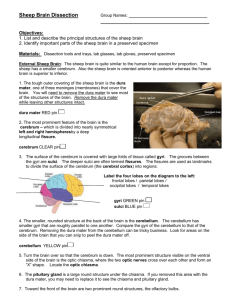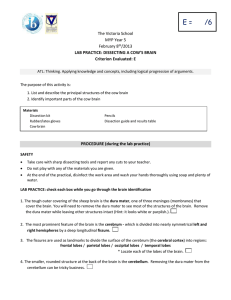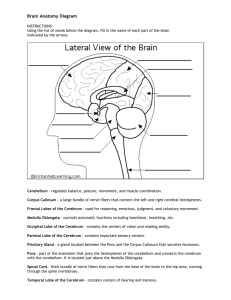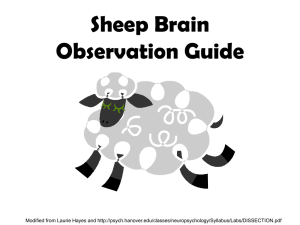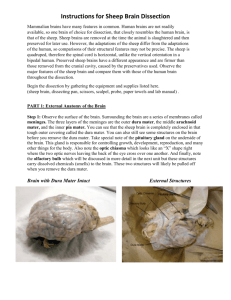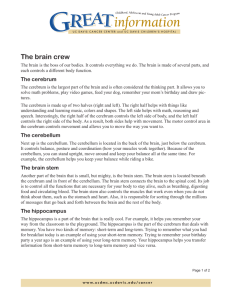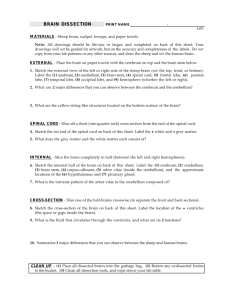B. Internal Sheep Brain.
advertisement
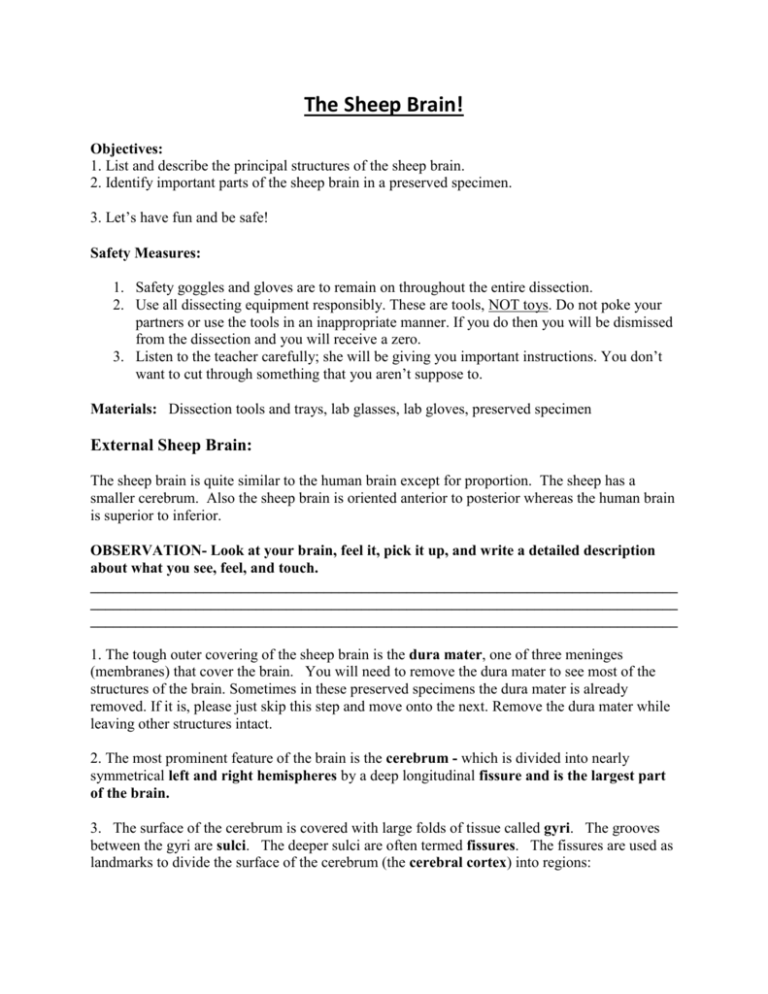
The Sheep Brain! Objectives: 1. List and describe the principal structures of the sheep brain. 2. Identify important parts of the sheep brain in a preserved specimen. 3. Let’s have fun and be safe! Safety Measures: 1. Safety goggles and gloves are to remain on throughout the entire dissection. 2. Use all dissecting equipment responsibly. These are tools, NOT toys. Do not poke your partners or use the tools in an inappropriate manner. If you do then you will be dismissed from the dissection and you will receive a zero. 3. Listen to the teacher carefully; she will be giving you important instructions. You don’t want to cut through something that you aren’t suppose to. Materials: Dissection tools and trays, lab glasses, lab gloves, preserved specimen External Sheep Brain: The sheep brain is quite similar to the human brain except for proportion. The sheep has a smaller cerebrum. Also the sheep brain is oriented anterior to posterior whereas the human brain is superior to inferior. OBSERVATION- Look at your brain, feel it, pick it up, and write a detailed description about what you see, feel, and touch. ______________________________________________________________________________ ______________________________________________________________________________ ______________________________________________________________________________ 1. The tough outer covering of the sheep brain is the dura mater, one of three meninges (membranes) that cover the brain. You will need to remove the dura mater to see most of the structures of the brain. Sometimes in these preserved specimens the dura mater is already removed. If it is, please just skip this step and move onto the next. Remove the dura mater while leaving other structures intact. 2. The most prominent feature of the brain is the cerebrum - which is divided into nearly symmetrical left and right hemispheres by a deep longitudinal fissure and is the largest part of the brain. 3. The surface of the cerebrum is covered with large folds of tissue called gyri. The grooves between the gyri are sulci. The deeper sulci are often termed fissures. The fissures are used as landmarks to divide the surface of the cerebrum (the cerebral cortex) into regions: * Locate each of the lobes: frontal lobes / parietal lobes / occipital lobes / temporal lobes. Remember our lobe song!!! 4. The smaller, rounded structure at the back of the brain is the cerebellum. The cerebellum has smaller gyri that are roughly parallel to one another. Compare the gyri of the cerebellum to that of the cerebrum. 5. Turn the brain over so that the cerebrum is down. The most prominent structure on the ventral side of the brain is the optic chiasm, where the two optic nerves cross over each other and form an “X” shape. The optic nerve is responsible for connecting the brain and the eye. Locate the optic chiasm. 6. The pituitary gland is a large round structure under the chiasm. If you removed this area with the dura mater, you may need to replace it to see the chiasm and pituitary gland. The pituitary gland is responsible for hormone secretion during growth, reproduction, and metabolism. 7. Toward the front of the brain are two prominent round structures, the olfactory bulbs, which are responsible for relaying messages that have to deal with your sense of smell. 8. Toward the back of the brain, in order from the optic chiasm are bulges that indicate the midbrain, the pons, and the medulla oblongata. 9. Just behind the optic chiasm is a raised area or bump that indicates the infundibulum (also known as the pituitary stalk). This is where the pituitary was attached to (which was probably removed with the dura mater). 10. Occulomotor nerves may be visible to each side of the pituitary gland (or stalk). Or in some cases you may find them stuck to the dura mater that you removed with the pituitary gland. 11. Carefully bend the cerebellum to get an inside glimpse of the brain. The bumps you see (kind of resembles a “butt”) are the superior colliculi. The smaller ones underneath are inferior colliculi. The colliculi is responsible for getting visual signals from the retina, orientation to the head and eyes, eye movement, and the ability for the head to respond to stimuli. 12. If you gently push those structures down, you can see the tiny nub of the pineal gland. The pineal gland is the source of melatonin and is responsible for your sleep cycle or Circadian rythmn. B. Internal Sheep Brain. 1. Use a knife or long-bladed scalpel to cut the specimen along the longitudinal fissure. Watch your teacher before you do this. This will allow you to separate the brain into the left and the right hemisphere. Lay one side of the brain on your tray to locate the structures visible on the inside. You should also cut through the cerebellum. 2. The corpus callosum (looks like a C) had been connecting the two cerebral hemispheres and can now be clearly seen in the brain section. Remember that this is a bundle of nerve fibers that connects the right and left hemisphere. 3. The tiny space within the corpus callosum (which holds cerebrospinal fluid- cushions the brain, acts as a shock absorber, circulates nutrients and chemicals that enter through the blood and releases waste from the brain) is called the lateral ventricle. Underneath it, you can find the third ventricle. There are other ventricles within the brain, but those are the easiest to locate in a preserved specimen. The white area between those two ventricles is the fornix. The fourth ventricle is the space under the cerebellum. 3. Inferior to the corpus callosum is a round structure known as the thalamus which is responsible for relaying motor and sensory information. Just behind the thalamus is the pineal body (gland). The hypothalamus is also round shaped but is lower and toward the front of the brain. The hypothalamus is responsible for hormone productions and maintaining many homeostatic functions such as temperatures, moods, sleep, hunger, thirst, sex drive, etc. 4. The pons, medulla, cerebellum and spinal cord are also visible in the side view of the brain. Gently separate the cerebellum at the transverse fissure, which separates it from the cerebrum. 5. Within the cerebellum, you can see the arbor vitae, named such because the white lines resemble a tree. It brings sensory and motor information back and forth to the cerebellum. 6. Use a scalpel to cut a cross section of the cerebrum in the occipital lobe area. You should be able to see the color and texture differences of the white matter and the gray matter. Now you may explore the brain and make cuts wherever you would like. Sheep Brain Dissection Analysis: Match the structure to the description. 1. ___ Arbor Vitae 2. ___Lateral Ventricle 3. ___Optic Chiasma 4. ___Superior Colliculi 5. ___Dura Mater 6. ___Cerebellum 7. ___Pineal Gland 8. ___Thalamus 9. ___ Pons 10. ___ Olfactory Bulb a. looks like a butt' b. leathery covering over the entire brain c. cauliflower, the area toward the back of the brain d. behind the colliculi, looks like a little nub e. looks like a "tree" f. the rounded part of the brain stem g. shaped like an X h. large area under the corpus callosum i. space for fluid between the corpus callosum and the fornix j. contains nerves, connects to the far front of the brain Label the Brain This lab was taken and modified from www.biologycorner.com
